Informed Choices: Where Babies Sleep
Informed Choices: Where Babies Sleep
Across cultures and throughout history, babies have slept close to their mothers — day and night. In the early months of life, this arrangement provides everything a baby needs: warmth, protection, comfort, and nourishment. Before modern technologies, survival without this closeness was nearly impossible.
Today, babies can be kept alive and well without direct maternal contact. Innovations like formula, incubators, and cribs have transformed infant care. Products have taken on roles once held by caregivers. But as we’ve adapted babies to fit our modern lifestyles, we haven’t always asked whether our environments still meet babies’ biological and emotional needs — especially when it comes to sleep.
There’s often a mismatch between what babies are biologically primed to expect and what our 21st-century settings provide. Navigating these conflicting demands can feel overwhelming, particularly when safety guidance clashes with a baby’s behaviour or a parent’s exhaustion.
Even with the best-laid plans, babies don’t always sleep where or how we expect. When sleep doesn’t go according to plan, what’s the next safest option? How can parents make informed, low-risk choices — even under pressure?
There’s no one-size-fits-all answer. Every family’s needs, circumstances, and sleep setups differ. In the sections that follow, we explore where babies sleep, why certain recommendations exist, who they apply to, and what to consider when your reality doesn’t match the ideal.
Click through to learn about the research on common baby sleep locations:
Room-sharing: Baby in Cot
Having your baby sleep near you reduces the risk of Sudden Infant Death Syndrome and makes night-time care easier.
Having your baby sleep in a cot in the same room as you until they are 6 months or even a year old is a key piece of advice given to new parents in many countries. There are two main reasons for this:
SIDS Risk Reduction
Studies across Europe, in England, the United States and New Zealand have shown that sleeping babies in the same room as their parent(s) is associated with fewer SIDS deaths (sudden unexplained infant deaths) compared to babies sleeping in a room alone. This does not mean that room-sharing protects every baby, but the amount by which room sharing reduces the chance of SIDS is large, and is found for both daytime and night-time sleeps (Blair et al., 1999). A large study looking at SIDS cases in 20 locations across Europe estimated that 36% of SIDS deaths could have been prevented if the baby had slept in a cot in the same room as the parents (Carpenter et al, 2004 ADD TO REF PACK). One large UK study found that 75% of the day-time SIDS deaths occurred while babies were alone in a room (Blair et al., 2006).
Feeding and responsiveness
Research on mothers and babies after delivery indicates that compared to sleeping baby alone, sharing a room also has other benefits (Yamauchi and Yamanouchi, 1990; Keefe, 1987):
Night-time feeding is easier, babies cry less when close to their parent/s, increased parental response to infant signals, and some studies have found room-sharing results in more sleep for parents and babies (Ball, 2025).
Reasons for keeping babies close also apply for day-time sleeps or naps as well as night-time sleep. Babies are always safer if they sleep in the presence of an adult caregiver compared to sleeping in a room on their own, so during the day your baby is safest if they are sleeping near to an adult who is looking after them.
Cot Safety
All new cots sold in the UK must meet European Safety Standards and should carry the British Standards Institution (BSI) number BS EN 716:2008, which indicates that they comply with the required safety standards. However hand-me-down or second-hand products may be defective, or produced before current safety standards were implemented. The Consumer’s Association provides guidelines regarding safety of new and second-hand cots. In the US drop-sided cots have been banned since June 2011 due to infant deaths and product recalls; no such ban has been proposed for Europe.
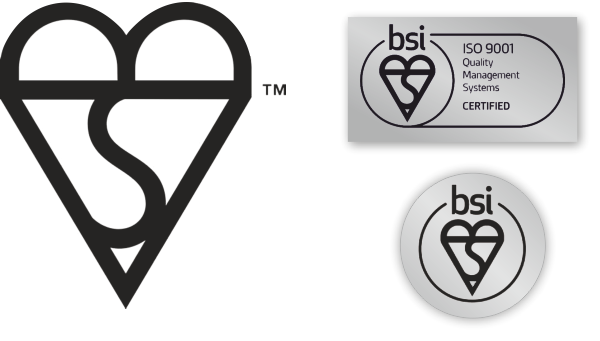
Research has not found any link between mattresses and SIDS. The Lullaby Trust recommend cot mattresses should be clean and dry with no tears, cracks or holes, and if possible purchase a new mattress for each baby. The mattress should fit the cot without gaps. The Consumer’s Association provides guidance on these products, as does NHS Choices. Think about where you place your baby’s cot and ensure it is away from radiators, curtains, and hanging cords.
Room Alone
Having a baby sleep in a separate room increases the risk of Sudden Infant Death Syndrome (SIDS) and makes it more difficult to respond quickly to their needs.
Official guidelines tell parents to keep babies in the parent(s) room until they are at least 6 months old. This is because the risk of SIDS (also referred to as cot death) is greater for babies who sleep on their own compared to sleeping in the presence of an adult (Blair et al., 1999).
Despite this advice some parents have their baby sleep in its own room from birth because they have prepared a room for the baby, and others move their baby to a separate room at around 3 months of age (babies are most at risk of SIDS at 2-3 months of age).
Sometimes this is because there is no room for a cot/crib in the parents’ room when a baby outgrows a Moses basket. Other times it is because the baby is preventing one or both parents from sleeping. A greater proportion of formula-fed babies sleep in separate rooms or are moved to a one in their first few months as compared to breast-fed babies (Ball, 2003).
In order to get their parents’ attention babies who are in a separate room may have to cry loudly and it can take a long time to calm them down enough to feed or to return to sleep (Ball, 2025). While self-soothing is something babies can start to do when they are older, young babies may not be ready to self soothe, or to sleep for long periods, and there is a lack of evidence about the harms or benefits of sleep training regimes that involve leaving babies alone to cry.
Understanding The Research
We provide the research on sleep locations to help you understand and inform safe sleep practices with your baby. As a research-based site, BASIS prioritises bringing the research to you to inform your decisions. Click through to learn more about rooming separately below:
Sofa-Sharing
Avoid Falling Asleep with Your Baby on the Sofa
Sleeping with your baby on a sofa, armchair, or makeshift bed like a beanbag is extremely hazardous. Babies can become trapped or wedged between cushions, arms, or a sleeping adult, with a high risk of suffocation. This environment also significantly increases the risk of Sudden Infant Death Syndrome (SIDS). A UK study (conducted between 2003 and 2006) found that 16% of SIDS babies had died while sleeping with an adult on a sofa. In comparison, only 1% of the control babies (a matched-comparison group of babies who did not die) slept on a sofa with an adult (Blair et al., 2009).
Sofa SIDS Risk
SIDS deaths have decreased in most sleep environments, but sofa-related deaths have gone up — possibly because more parents are trying to avoid bed-sharing by feeding or settling babies on the sofa (Kendall-Tackett et al., 2010). The risk of SIDS on a sofa is estimated at 1 in 180, compared to the general risk of 1 in 3,300 (Blair et al., 2014). US and UK research also shows that infants who die on sofas are more likely to be sleeping on their side or in shared spaces — both known SIDS risk factors — and to have mothers who smoked or used drugs during pregnancy (Rechtman et al., 2014; Ball et al., 2012).
Safer Alternatives
Tired parents often end up feeding or settling their baby on a sofa to avoid disturbing others — but this can lead to accidental sleep in a dangerous setting. In many cases, falling asleep in bed with baby is safer than on the sofa. That’s why it’s crucial for all families to receive guidance on how to make bed-sharing safer, to prevent hazardous sofa co-sleeping.
Baby Boxes vs Sleep Nests and Pods
What are baby boxes? Where are they used today?
New parents in a variety of locations will nowadays receive a Baby Box around the time their baby is born. All baby boxes consist of a mattress and a fitted sheet that will allow the box to be used as an infant sleep space within usually a plastic or cardboard box. In some locations (Finland, Scotland), Baby Boxes are given out as a gift from the Government to new parents, and they are packed full of useful items for the baby’s first year of life (Skea et al., 2022). In other locations, Baby Boxes are being given out by NHS Trusts and Local Authorities as part of infant safe sleep education (Bally and Taylor, 2020). Similarly, a team in New Zealand have promoted a wahakura, a Māori innovation based on traditional baskets handwoven from flax, as a tool for parents to use in their bed as a safe sleep location for their infant. Following the earthquake in Christchurch, New Zealand, emergency bedding for newborns was located in the form of a plastic box with a mattress insert, referred to as a Pēpi-Pod® (pēpi being the Maori term for baby). Subsequently the New Zealand government piloted the Pēpi-Pod® programme which consists of both providing parents a Pēpi-Pod®, i.e. plastic baby box, as well as infant care education (Ball et al., 2021). This culturally-targeted safe sleep enabler for indigenous communities contributed to a drop in SIDS, particularly in Maori communities (Ball et al., 2021; The Pēpi-Pod® Program, 2022).
Additionally, several major retailers and other specialist companies are producing retail versions of Baby Boxes designed to be purchased as gifts for new families, full of premium products (Ball and Taylor, 2020).
It can be useful to have a portable sleep space such as a cardboard Baby Box for use during the day, or if you are sleeping away from home. If you do not have access to a Moses basket or cot it is safer for your baby to sleep in a box than in a car seat or on a sofa.
Baby Box Safety Considerations
Be sure to use your Baby Box safely and follow the manufacturer’s or distributor’s instructions. Do not place a Baby Box on a high or precarious surface where it (and your baby) might fall. Do not use it to carry your baby, or place near a heat source. Baby boxes are not safe for transporting babies in cars or other vehicles.
All baby box mattresses should carry a permanent label stating that they comply with UK and EU regulations, including fire safety. Do not use a mattress that does not have this label. Always place your baby on their back in the box and keep the box free from toys and excessive bedding. Stop using the box as soon as your baby begins trying to roll over.
The Lullaby Trust (UK SIDS Charity) has issued a statement about the safety of Baby Boxes that can be found on their website as you scroll down.
As with all infant sleep spaces, Baby Boxes should be used with common sense and safe sleep guidance should still be followed.
Co-sleeping nests and pods
There is an expanding market of nests and pods being marketed for use in the parental bed, with the intention that they will keep babies securely in one place and, by the use of padded sides, prevent parents from overlying the baby. While there is merit in the idea of providing the baby with a safe space within the parents’ bed (as per the New Zealand Pepi-Pod and Wahakura programmes), pods and nests designed for bed-sharing can be problematic and are not the same as baby boxes (Ball, 2025). Many parents who purchase or are gifted these sleep nests or pods for their infant to sleep in, but upon reading the manufacturers instructions it is often revealed that these products are intended for when the infant is both awake and supervised and not recommended as a sleep location (Ball, 2025).
Nest and Pod Sleep Safety
One key component of safer sleep guidance is to keep the baby’s sleep space clear and flat; clear from pillows, cushions, bumpers, soft toys etc, and flat rather than inclined, saggy, or squishy. Soft and squishy items in the sleep space create two hazards for babies:
- they can block a baby’s nose and mouth and make breathing difficult or impossible
- they can insulate a baby’s head and prevent them from loosing heat leading to overheating
The physiological stresses of overheating via head covering or struggling to breathe via airway covering are both associated with SIDS, while airway covering can also lead to suffocation.
Placing babies to sleep in pods/nests that surround them with a squishy cushion-like barrier made of insulating material therefore contradicts these aspects of safer sleep guidance (Ball, 2025). It is also why Pepi-pods and Wakahura have rigid sides with no padding.
In our infant sleep research we have found pods and nests are very popular with parents who feel their baby sleeps well (longer, or more deeply) when place in one of these products, and parents often place pods/nests inside their baby’s cot to make it feel more comfortable and cosy.
But it is important to remember that prolonged and deep sleep in early infancy is also associated with an increased chance of SIDS — when babies sleep deeply they fail to arouse to face covering and other physiological challenges. In early infancy it is normal for babies to spend most of their sleep time in the lighter phases of sleep, and to arouse frequently.
If you have bought or been given a baby nest or pod it is safest to only use it when your baby is awake, and to ensure they sleep on a flat clear surface away from any pillows, soft toys etc.
If you are unwilling/unable to place your baby on a safer surface for sleep, then avoid leaving your baby alone while asleep in the nest/pod. Be sure they are in the same room as a carer who is watching them and checking on their safety.
Using a pod/nest while bed-sharing / co-sleeping is not necessary and can introduce an additional hazard to the sleep environment. If you are planning to bed-share (or even if you aren’t, as bed-sharing can happen by accident) baby-proof your bed to give your baby a clear flat surface to sleep on next to you. See this information from Lullaby Trust on preparing your bed for safer bed-sharing.
Side-Car Cribs, Bed-Side Cots, Co-Sleepers
Having your baby sleep in a cot or Moses basket in the same room as a care-giver, for all day-time and night-time sleeps, until they are six months old, is a key piece of the advice given to new parents for reducing the risk of SIDS.
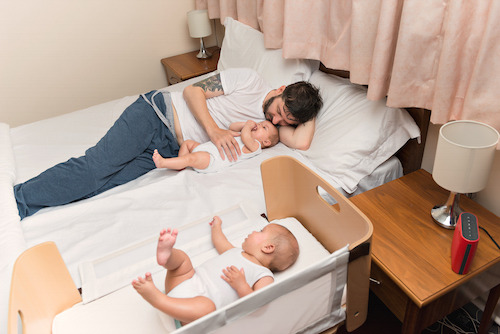
Furniture Options
There are different types of furniture available that parents may use for keeping their babies close at night. Some parents place their baby to sleep in a standard cot, cradle or moses basket, located next to their bed or elsewhere in their bedroom. Other parents place their baby to sleep in a three-sided cot which is joined to the parents’ bed. This provides easy access to, and contact with, the baby, as well as a separate sleep surface. These are often known as side-car cribs or bed-side cots, and are sometimes known as ‘co-sleepers’ (especially in the US). In the UK bed-side cots are increasingly popular and there are now several different types available in a variety of sizes.
Safety Considerations
Different bed-side cots incorporate various features, but all have the facility to keep the baby close to a parent with no barrier to hinder night-time contact. A safe bed-side cot should fasten to the parents’ bed or have locking wheels to prevent it from being accidentally moved away from the bed while the baby is in the cot. There should be no gap between the cot/crib and the bed. It should also include a detachable or moveable 4th wall that can be secured in place if the baby is left to sleep in the crib alone. It is desirable if the height of the cot/crib can be adjusted to match the height of the adult bed.
Sometimes parents make their own side-car cribs by removing the side-wall of a standard cot and somehow fastening the cot to the adult bed. With the 4th side permanently removed from the cot it is not safe to leave babies unattended, and it can be difficult to adjust the height of the cot to match the height of the bed, leaving the potential for gaps in which a baby might get trapped.
Research Gap
To date, no research has investigated whether one type of cot helps with feeding or sleep more than another in the home. Marketing information and parents’ reviews indicate that 3-sided cots are popular with breastfeeding mothers, especially when they are recovering from c-section deliveries, or when their babies are small and feeding frequently at night. The research conducted on 3-sided cots has primarily examined their use in hospital post-natal wards, but a US study investigated the dangers and injuries obtained by infants using at-home co-sleepers. They concluded that when used appropriately they are just as safe or safer than any other type of cot/crib and accidents remain very low overall.
Understanding the Research
We provide the research and evolutionary theories behind our sleep aid content to help you understand and inform safe sleep practices with your infant. As a research-based site, BASIS prioritises bringing the research to you to inform your decisions. Click through to learn more below:
In UK hospitals, it is standard practice for babies to ‘room-in’ with their mothers on the postnatal ward. Typically babies sleep in a standard bassinette (a four-sided plastic box that sits in a metal frame with wheels. Some hospitals now also use side-car cribs (a three-sided bassinette that securely clamps onto the side of the mother’s hospital bed, or is atop a hydraulic stand that can be locked in place and tethered to the mother’s bed).
Side-car cribs are very popular with mothers following delivery as they are more easily able to see, touch, and pick up their babies from this location. Mothers recovering from episiotomies and caesarean incisions, who have limited mobility, find them particularly beneficial (Klingaman, 2009).
After a vaginal, unmedicated delivery, using a side-car crib on the postnatal ward helps mothers and babies to breastfeed more frequently, which contributes to increasing the overall duration of breastfeeding (Robinson, 2014). There is no difference in the total amount of sleep both mothers and babies get based on the type of cot they have on the postnatal ward (Tully and Ball, 2012).
A large randomised trial examining the general use of side-car cribs for all mothers and babies, regardless of delivery type, did not find an increase in long-term breastfeeding duration (Ball et al., 2011).
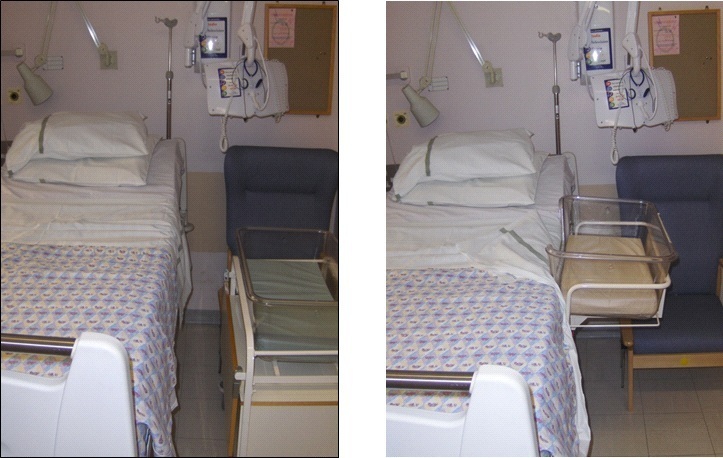
Several research studies have investigated the impact of infant sleep location on the postnatal ward (standard cot versus side-car crib) on breastfeeding outcomes. To date, research has found that following an unassisted, unmedicated vaginal delivery, infants assigned a side-car crib breastfed significantly more frequently whilst on the postnatal ward, and breastfed for longer after leaving hospital, compared to infants who were assigned a standard cot (Ball et al., 2006; Ball, 2008; Robinson, 2014).
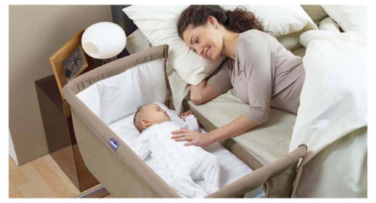
These results have not, however, been replicated following deliveries where mothers received opioid labour analgesia or obstetric intervention (i.e. instrumental delivery and/or caesarean section delivery) (Ball et al. 2011; Tully and Ball 2012). The World Health Organisation (2009) recommend having one’s infant easily accessible postpartum. This is supported by Tully et al. (2014), adding that this is not successfully accomplished in stand-alone cots, suggesting side-car cribs as the optimal strategy.
No studies have found any evidence that side-car cots pose any risk to babies. One study (Tully and Ball, 2012) suggested that following a caesarean section delivery, the height and angle of a standard cot posed several potential risks to infants whose mother’s movements were impaired as a result of the caesarean section procedure. The observed risks associated with the standard cot after caesarean section delivery included mothers lifting the infant without supporting their head, tipping the cot whist attempting to place the infant within it, dropping the infant into the cot and prone infant sleep. An American Academy of Pediatrics report on Safe Sleep and Skin to Skin Contact in the Neonatal Period highlighted the potential of side-car cribs for enhancing infant safety on the postnatal unit (Feldman-Winter et al 2016).
Thompson and Moon (2016) investigated the dangers and injuries obtained by infants using at-home co-sleepers. They concluded that when used appropriately they are just as safe or safer than any other type of cot/crib and accidents remain very low overall.
Research has found that bed-sharing can be associated with a baby experiencing an increased chance of SIDS or accidental death in particular circumstances. These are a) If you smoke (or smoked in pregnancy), b) have recently drunk alcohol, or taken drugs or medications that make you sleepy or sleep more heavily than normal, and c) your baby was born prematurely or with low birth-weight. Read more at safe sleep guidance.
In these circumstances, side-car cots may provide a safer alternative to bed-sharing, and provide easy access for comforting and feeding your baby during the night.
Regardless of mode of delivery, mothers have expressed an overwhelming enthusiasm and preference for side-car cribs whilst on the postnatal ward (Tully and Ball, 2012; Tully et al., 2014). Mothers stated that side-car cribs, unlike standard cots, permitted visual and physical access to their infants; enabled emotional closeness; facilitated breastfeeding; allowed them to settle their infant quickly; and minimised calls to postnatal ward staff.
Following a caesarean section, mothers commented unfavourably about standard cots compared to side-car crib use (Tully and Ball, 2012; Tully et al., 2014). Furthermore, side-car cribs can play an important role in promoting mother-infant contact and successful breastfeeding initiation amongst these dyads (Tully et al., 2014). This is significant, as this method of non-labour induced delivery tends to result in lower rates of breastfeeding overall due to inhibited lactation and physical pain.
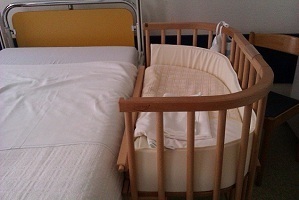
Similar findings were reported following an audit of different cot-types trialled on Belgian postnatal wards which led to some hospitals adopting a practice of exclusively using side-car cribs on the post-natal ward (wooden variety, see picture below right, which are different in design to those commonly used in UK). (Martine van Haver, Midwife, Lueven, pers comm 2012).
Last Reviewed: July 2025
